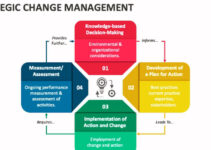It is significant for businesses and organizations to keep changing and relevant to the shifting environmental trends of the global economy. Before executing the change plan, it is important to know the type of change you want to launch. Today, we’ll discuss the 12 common types of organizational change.
The organizational change you’re planning to launch in the company could be in the following forms;
- Technological Change
- Strategic Change
- People-Centric Change
- Unplanned Change
- Cultural Change
- Operational Change
- Adaptive Change
- Reactive Change
- Anticipatory Change
12 Common Types of Organizational Change
Let’s discuss the 12 common types of organizational change, and they’re as follows;
Culture & People Change
Cultural change is a type of organizational change that shifts the organizational behavior, values, custom, and culture of the company in order to achieve efficiency. It comprises launching such policies and procedures at the corporate level that would establish an environment where people feel safe, valued, supported, and empowered.
In order to boost the morale of people toward change, often companies offer incentives for the smooth transition of the change. It also makes sure that the company keeps on performing various functions and operations efficiently. The change leaders develop a culture of cooperation, innovation, creativity, coordination, and user engagement. However, they offer training and development programs for employees, so that they could comprehend the value of change and how it would benefit them.
System & Process Change
Process and system change is a type of organizational change that focuses on modifying the company’s prevailing system and processes. It comprises launching new technological tools, systems, applications, and software that would alter their operations and work and make it more efficient and effective. Ultimately, it amplifies growth and productivity in the workplace.
Remedial Change
Remedial change is a form that focuses on improving and rectifying the company’s prevailing structures, processes, systems, operations, functions, and methods of doing things. Often, it comprises diagnosing and resolving the prevailing problems; launching strategies that would remove inefficient areas, and easing complicated procedures and methods. However, when you remove the errors and complicated processes, the company’s operations become much smoother.
Developmental Change
Development change is a form of organizational change that focuses on improving and building on the company’s prevailing structures, processes, and capabilities. Usually, it consists of launching technological tools, systems, processes, and structures for the efficiency of the workplace.
However, it doesn’t focus on throwing the prevailing systems and processes; rather it builds a new system and processes based on the foundation of the existing system, structure, and processes. It comprises launching new technological tools and methods that would employees become a productive member of the organization.
Incremental Change
Incremental change is a form of organizational change that brings small and effective changes in the company’s system, structure, process, methods, and strategies. It follows the principle that continuous series of small changes would bring large changes in the organization.
However, it is completely different from the transformation that focuses on throwing away the existing system and process. When you bring small modifications and improvements in the existing processes and systems, then it amplifies the overall productivity and growth.
Transformational Change
Speaking of transformational change is a form of organizational change that focuses on bringing radical changes and transforms how the company plans, organizes, manages, and performs various operations. It comprises launching new methods, procedures, policies, systems, processes, and structures for daily operations, completely different from the previous one.
Usually, the focus of transformational change is to rebuild the prevailing system or radically launch a new system or solution that covers various departments of the company. It is a form of change that demands a higher level of commitment from the top management and its employees. Often, it requires quitting the old methods of doing things and implementing the new ones.
Rebranding Change
Rebrand is a form of organizational change that focuses on improving and upgrading the company’s public image and brand reputation in order to make it charming and attractive to its customer market. Various external factors trigger the rebranding change in the company like shifting market trends, changes in the marketplace, retargeting, changing segments, or something else.
Often, the concept of rebranding comes from the merger and acquisition or joint venture. When two or more organizations share their resources, positioning, capabilities, and assets; then it results in the form of a new brand or entity. However, it allows companies to exploit the changes and establish a new identity completely different from the competitors.
Relocation Change
Relocation change is a form of organizational change that focuses on shifting some units of the organization to a place or location. The relocation could be in the form of transferring to another country or geography, or relocation of the units, departments, offices, and employees.
Often, relocation offers a lot of changes to the organization like cheap labor, availability of raw materials, or talent; but the process of relocation is complex. It helps the company to take advantage of the new marketplace, geography, or culture; improves the overall productivity and growth of the company.
Downsizing or Lay Off Change
Downsizing is a form of organizational change that focuses on decreasing the size o the company. Often, it comprises reducing the cost to lay off employees in order to improve the growth, productivity, and efficiency of the organization. Businesses and companies launch downsizing programs for strategic purposes; like when they need to reallocate their resources to their core operations because the company’s size has become very large.
De-merger Change
De-merger change is a form of organizational change that focuses on breaking up the company into two or more separate entities. Often, companies employ this change strategy when its size has become too large; dividing the company helps them to streamline various processes and operations in order to improve efficiency and productivity.
However, it consists of dividing the company into various parts, departments, and units into separate distinct entities; but they keep them integrated and have control over them.
Merger & Acquisition Change
As the name implies, it focuses on the merger and acquisition of two or more organizations. Often, it comprises integrating operations, processes, resources, and workforce of two or more companies and making them one. However, M&A plays a significant role in the growth and productivity of the company because it integrates the strong points of two companies and makes them one.
Structural Change
Structural change is a form of organizational change that focuses on altering the company’s structure. Usually, it consists of launching new methods, procedures, policies, systems, and processes in order to reduce waste and improve the overall efficiency of the company. The structural change also means re-organizing the company’s departments and realigning them with the company’s mission, vision, strategies, and objectives. It could also be in the form of bringing hierarchical changes and making the company’s structure cohesive and collaborative.
Conclusion: 12 Common Types of Organizational Change
After an in-depth study of 12 common types of organizational change; we have realized that organizational changes are significant for a company’s growth and productivity. If you are learning about organizational change and its various types, then you should keep in mind the abovementioned types.
Ahsan is an accomplished researcher and has a deep insight in worldly life affairs. He goes Live 3 days a week on various social media platforms. Other than research writing, he’s a very interesting person.


